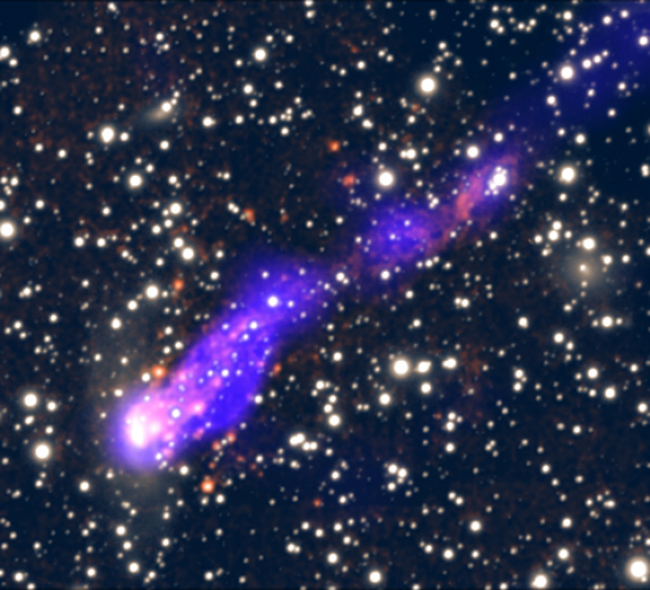
 Credit: -ray: NASA/CXC/MSU/M.Sun et al; H-alpha/Optical: SOAR (MSU/NOAO/UNC/CNPq-Brazil)/M.Sun et al.
Credit: -ray: NASA/CXC/MSU/M.Sun et al; H-alpha/Optical: SOAR (MSU/NOAO/UNC/CNPq-Brazil)/M.Sun et al.
Rushing Downhill
Galaxies in clusters rush around at enormous speeds, millions of miles per hour, like a swarm of hyperactive bees around a hive. Imagine the enormous energy needed to make an entire galaxy of hundreds of billions of stars move so quickly. They are held in check by enormous quantities of dark unseen stuff that only appears to generate gravity, nothing else. Moving at such high speeds is a dangerous activity of course. Bad things can happen. An example is the galaxy ESO 137-001, speeding downhill towards the center of gravity of the giant cluster Abell 3627. The image above displays an optical image of the region around ESO 137-001, along with an X-ray image from the Chandra X-ray Observatory. The X-ray image shows a glowing hot trail of stuff 130,000 lightyears long, stripped from the galaxy. This stuff isn't simply lost to intergalactic space, however; the optical image, from the SOAR Telescope, astoundingly shows that, within this hellish environment, new stars are condensing.
<
HEA Dictionary ● Archive
● Search HEAPOW
● Other Languages
● HEAPOW on Facebook
● Download all Images
● Education ● HEAD
>
Each week the HEASARC
brings you new, exciting and beautiful images from X-ray and Gamma ray
astronomy. Check back each week and be sure to check out the HEAPOW archive!
Page Author: Dr. Michael F. Corcoran
Last modified Monday, 26-Feb-2024 17:34:20 EST


